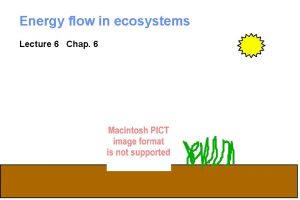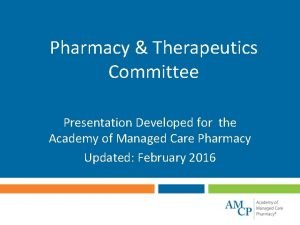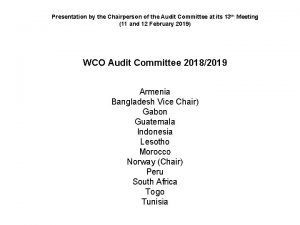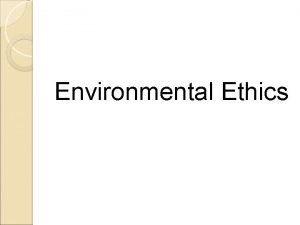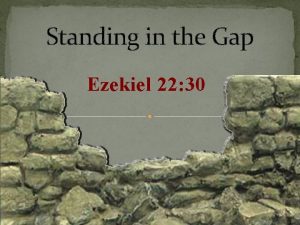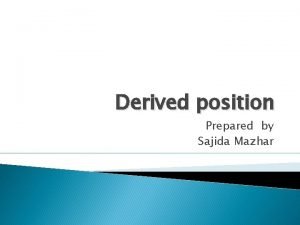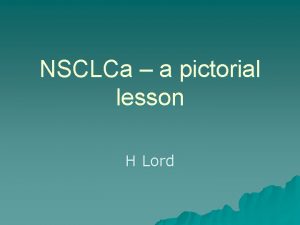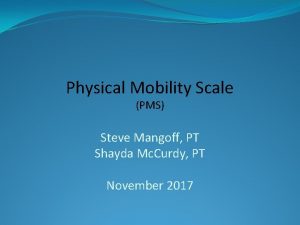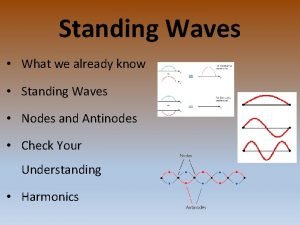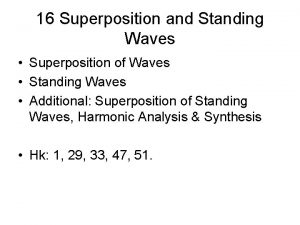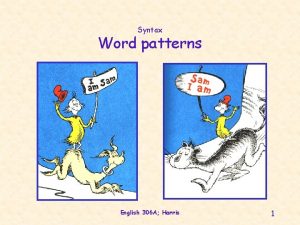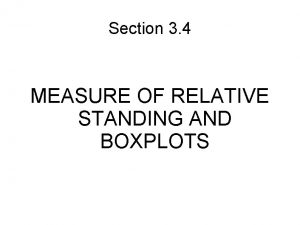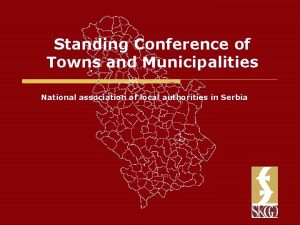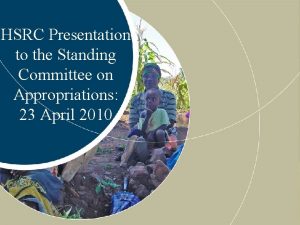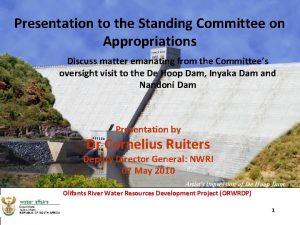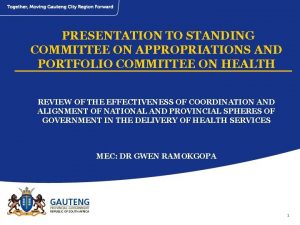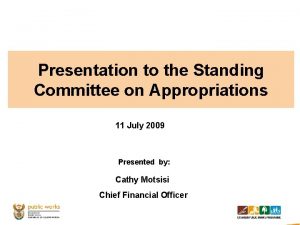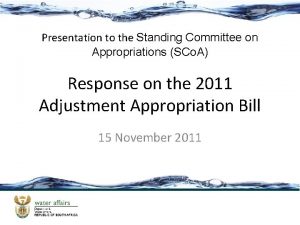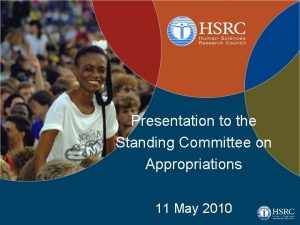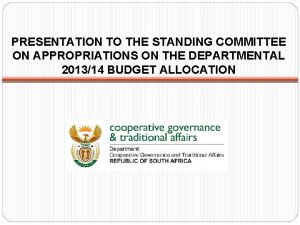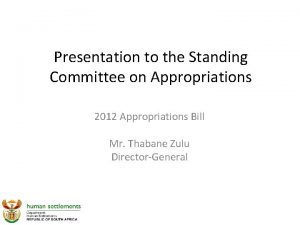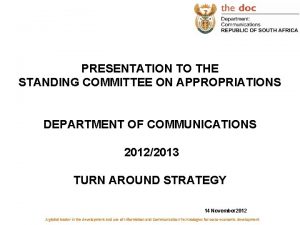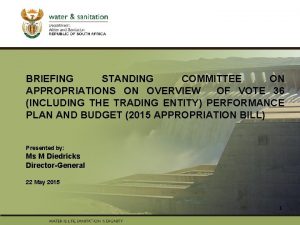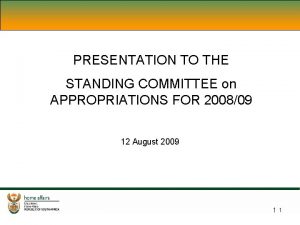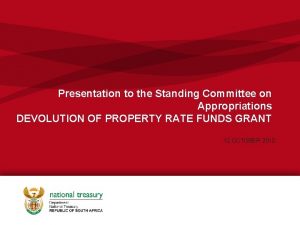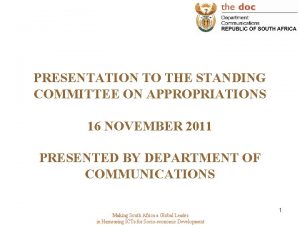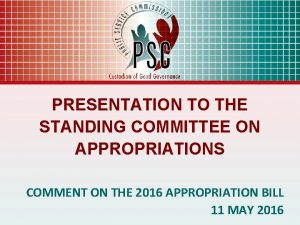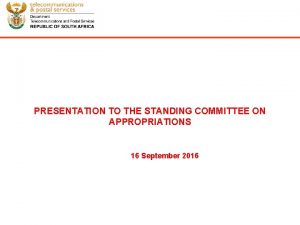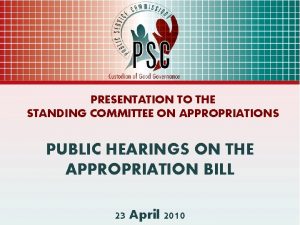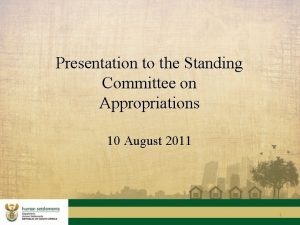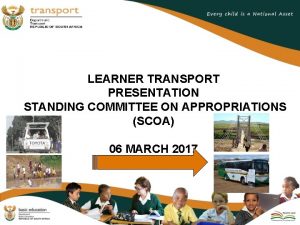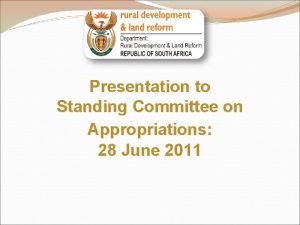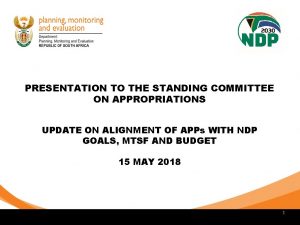HSRC Presentation to the Standing Committee on Appropriations

![Overview: Appropriations Bill [B 3 -2012] and the five government priorities In the context Overview: Appropriations Bill [B 3 -2012] and the five government priorities In the context](https://slidetodoc.com/presentation_image_h2/7496dfc817f718f166ae4a770ff41d99/image-2.jpg)



















































































- Slides: 85

HSRC Presentation to the Standing Committee on Appropriations 29 May 2012 HSRC delegation led by Dr Olive Shisana, CEO Social science that makes a difference
![Overview Appropriations Bill B 3 2012 and the five government priorities In the context Overview: Appropriations Bill [B 3 -2012] and the five government priorities In the context](https://slidetodoc.com/presentation_image_h2/7496dfc817f718f166ae4a770ff41d99/image-2.jpg)
Overview: Appropriations Bill [B 3 -2012] and the five government priorities In the context of the current economic climate, the HSRC delegation presents research-based views on issues wrt the following government priorities: Decent Work Education Crime Health Rural Development and Agrarian Reform Social science that makes a difference

Decent Work Policy Context • • Weak performance of the SA economy and job creation in the last few years Chronic levels of unemployment and worklessness, especially among youth High levels of ‘working poor’ (low wages) Wide geographical variations in employment and income Social science that makes a difference

Major spatial inequalities, compensated by grants Main source of household income, 2002 -10

Informal urban areas have high employment

But low earnings

Total population of urban & rural areas (UN)

Decent Work Strengths of the Appropriation Bill include • • • Aim to shift investment from consumption to investment Commitment to a bold infrastructure plan serving whole country; integrated approach; speedy delivery Increased support for Industrial Policy Action Plan; special economic zones; Investment in transport can improve living standards for workers, cut transport costs and increase productivity Attention given to rural development, and the Community Works Programme Social science that makes a difference

Decent Work Uncertainties about the Appropriation Bill include: Unclear direction of pertinent economic policies – tentativeness Imperatives for current emphasis on social spending rather than economic development No agreement on how to promote labour-absorbing growth No strong economic pacts with business and labour at national, provincial and local levels (‘jobs growth coalition’) Weak and fragmented active labour market programmes, no youth focus No emphasis on (integrated) economic development and employment policies at city-level, despite urbanisation Emphasis on compliance, not capacity building Social science that makes a difference

Education The storyline for the presentation is an analysis with a skills development lens: examining extent to which government policies have been effective. The skills story is messy, sometimes contradictory, some successes, strong commitments & some unintended consequences Social science that makes a difference

Lack of work experience leaves graduates unemployed

Skills and industrial production: SA and Africa need to feature in this story



The Analysis • • Since 1994, government has implemented many active labour market strategies to change the skills profile in the country. We will examine FET colleges, universities, and training in public institutions to measure impact (both in terms of reach and labour market absorption). Social science that makes a difference

Characteristics of Post School Sector • Fragmented and uncoordinated system • Universities preferred providers of post-school education • • • Demand exceeds provision in universities, but FET colleges are under-enrolled Low throughputs and low quality qualifications Green Paper for Post-School Education and Training attempts to co-ordinate the sector Social science that makes a difference

FET Colleges FET colleges key providers of intermediate-level education and training. Too many changes in sector: needs equilibrium Low enrollments: must make these institutions attractive to students & invert university & FET college enrollment Poor throughput rates Curriculum must be more closely linked to industry Need appropriate lecturing staff (R 499 m -teaching and development grants for FET lecturers) Social science that makes a difference

FET Enrolments 2007 -2010 Total NATED Total NCV Other enrolments Total enrolled 2007 245, 230 31, 414 45, 449 322, 093 2008 178, 086 81, 742 41, 250 301, 078 2009 175, 999 166, 469 42, 638 385, 106 2010 169, 803 122, 257 40, 520 332, 580 2011 * * * 437, 060 * Breakdown unavailable

College efficiency rates (NATED courses) Mean annual throughput rates, ‘N’ courses, 2007 -2009, FET colleges (%) N 1 N 2 N 3 N 4 N 5 N 6 Business Studies Engineering Art and Music Utilities Educare and Social Services 33 16 - - - 15 19 19 17 * 28 24 54 31 * 47 31 43 33 39 45 30 40 45 46 47 24 33 36 62 Source: HSRC (2011)

College efficiency rates (NCV) Mean throughput rates for selected NCV programmes, 2007 -2009, FET colleges (%) FIELD Marketing Finance, Economics and Accounting Building Engineering and related Design 40 45 35 26 29 45 48 55 22 30 56 55 53 24 22 Office administration Passed NCV 2 Passed NCV 3 Passed NCV 4 Source: HSRC (2011)

Spatial Location of FET Colleges & universities

Universities • What are the employment/ labour market prospects after graduation? Social science that makes a difference

Unemployment Rates, by Institution and Race (Bhorat, HSRC publication, 2005 data) Institution Fort Hare Stellenbosch Univ. of the North Western Cape Witwatersrand African 0. 56 0. 55 0. 42 0. 29 White 0. 07 Total 0. 67 0. 13 0. 57 0. 3 0. 23 Peninsula Technikon 0. 51 --- 0. 41 Technikon Pretoria 0. 38 0. 06 0. 27 --- 0. 12 ----- Apartheid Classification of Institution Historically White 0. 42 0. 1 0. 27 Historically Black 0. 4 0. 06 0. 35 Total 0. 41 0. 09 0. 32

Broad Unemployment Rates by Field of Study Bhorat, HSRC publication, 2005 data Institution Type (apartheid classification) Historically Black Historically White African White Business/Commerce 0. 48 0. 46 0. 14 Education 0. 09 0. 24 --- Humanities 0. 58 0. 13 SET 0. 37 0. 42 0. 4 0. 33 0. 35 0. 42 0. 05 0. 19 0. 1 Race Other Total

Who are the unemployed science graduates? MATRIC PASSES Distinction Exemption Senior pass No Response 6% 69% 19% 6% Age 26 yr Female 61% Male 39% African 88% HIGHEST QUAL National Diploma Bachelors Honours Masters Matric Performance Click to edit Master subtitle style 13% 60% 26% 1%

Skills Development: Public Sector Expenditure on training : R 1. 8 billion 2009/2010 >205 000 people attending training Expenditure in government departments generally meets the 1% of personnel budgets requirement A paucity of information regarding the impact, length, appropriateness and quality of training The annual training reports and the Work Place Skills Plans, submitted to PSETA, are of a very poor quality Social science that makes a difference

Government expenditure on training (2009/10) Department Communications Water affairs Police Parliament Energy Health Labour HET Basic Education International Relations Expenditure (R, m) 9 50. 6 1253. 4 10. 1 2. 1 4. 5 8. 3 1. 9 1. 7 % of Payroll 6. 9 5. 6 3. 7 3. 1 1. 6 1. 4 0. 9 0. 8 12. 4 0. 6

KZN Treasury: good practice of skills training and impact assessment Department introduced the Impact Assessment Exercise where supervisors rate impact of training on trainees Trainees also evaluate the training, however supervisor ratings take precedence Some occupational mobility at lower ranks Social science that makes a difference

Employment changes by key sectors: 1998 -2010 Sector 1998 2010 % change over past decade Agriculture 435 000 296 000 -32. 2 Mining 935 000 614 000 -34. 3 Manufacturing • 000 1742 000 25. 8 Construction 509 000 1085 000 113. 2 Finance 704 000 1759 000 149. 9

Education: Some conclusions There are many government programmes to improve skills. We need to measure impact of training and look at how the post school institutions articulate with each other for a co-ordinate post school sector. There needs to be strong links between training and needs of the economy. Social science that makes a difference

Crime and Justice Public Concern with Crime and Corruption Crime and safety consistently rated as the third most important national priority by South Africans between 2003 and 2011, after unemployment and HIV/AIDS. Modest decline in percentage mentioning it after 2009. • Corruption is steadily escalating as a concern, especially after 2009. • Percent indicating that crime and safety and corruption represent national priorities facing South Africa, 2003 -2011 Social science that makes a difference

Crime and Justice Fear of Crime Fear of crime has generally remained high over the 2005 -2011 period, with only a small decrease in the last couple of years. 66% of South Africans feel unsafe walking alone after dark Percent indicating that crime and safety and corruption represent national priorities facing South Africa, 2003 -2011 Social science that makes a difference

Trust in the Police and Courts is low Percent that trust / strongly trust the following institutions 19 19 20 20 20 98 99 00 01 03 04 05 06 07 08 09 10 11 Mean Churches 82 81 74 81 81 82 82 83 84 83 80 81 SABC … … 75 73 71 72 … 73 73 75 66 72 IEC … 54 49 63 63 69 65 68 … 67 72 74 63 64 Defence force 48 45 49 62 56 59 49 … 56 64 62 60 56 Nat. gov 47 60 43 52 57 69 64 59 52 52 61 52 52 55 Parliament … … 57 65 59 55 46 48 56 49 46 53 Courts 42 45 37 45 50 58 56 52 49 50 57 56 51 50 The police 42 47 39 40 42 46 45 39 39 40 41 41 41 42 Your local gov 37 48 32 38 45 55 48 44 34 38 40 37 36 41 Political parties 30 39 29 27 … 32 … . . … … 42 37 27 29 34 29 30

Crime and Justice • • The Aim of Vote 24 (Justice and Constitutional Development) is to: Uphold and protect the Constitution and the rule of law, and render accessible, fair, speedy and cost effective administration of justice in the interests of a safer and more secure South Africa. 2. 41% of the Appropriations Bill is dedicated to the Vote, namely R 13 079 607 000 The department will prioritise service delivery in it’s core functions as reflected in the five programmes in the Appropriations Bill. There are questions about the appropriateness of the relative distributions of expenditures between programme. Social science that makes a difference

Crime and Justice The division on terms of the five programmes looks as follows Social science that makes a difference

Crime and Justice Integrated Justice Sector Services The Do. JCD Vote funds both core Integrated Justice Sector (IJS) services, and broader state legal and constitutional development services. Recently included was the Office of the Chief Justice. • Over the 12 years of spending, most of the growth in the Vote has been used for IJS services. The Protection and Integrated Justice Services sector includes the • • • Do. JCD Defence Correctional services Safety and security Independent complaints directorate Social science that makes a difference

Crime and Justice Growth in Do. JCD IJS spending was driven primarily by increased spending on the National Prosecuting Authority (NPA) programme. Within the programme, this high growth follows the creation of new and specialised services (eg. sexual offences) , but also growth in spending on prosecution services. The growth is spread fairly evenly throughout the 12 years. Increasing the capacity of the prosecution services aligns well with a longstanding national and departmental focus on increasing the efficiency of the courts. However, it is a concern that the growth in spending on prosecutors has not been better balanced with growth in spending on: Management and administration of the courts • The Legal Aid Board. • Social science that makes a difference

Making access to justice a priority 2011 Access to Justice Conference resolutions have budgetary implications: Restructuring/reasonably resourcing small claims courts, community courts and traditional courts; Prioritising education and training Introduction of alternative dispute resolution into the court system; Structures which monitor access to justice and the functioning of the courts at national, provincial, sub-cluster, and district level; More attention given to sexual violence cases and cases affecting children; Introduction and implementation of advanced court technology, audio-visual equipment and electronic filings; A pool of pro bono services should be rendered to the poorest of the poor Explore innovative ways of raising public awareness about access to quality justice; It is recommended that a dedicated allocation be made for the Office of the Chief Justice Social science that makes a difference

Crime and Justice What we need to fund Infrastructure (including physical access for the disabled) Access to judicial services in poor and rural areas Court security Judicial education (SAJEI) Special dedicated training and services: sexual offences, human trafficking, domestic violence and maintenance Strengthening the constitutional development portfolio Social science that makes a difference

Crime and the Police Low Police Confidence Less than half the adult South African population (41% in late 2011) vests confidence in the police; trend remained fairly consistent over last decade • Satisfaction with the government’s crime reduction efforts has generally been extremely low, but there are signs the post-2009 changes in policing approach are winning public support despite mounting concerns of police brutality • Percent that trust the police and express satisfaction with crime reduction efforts, 2003 -2011 Social science that makes a difference

Crime and the Police Perceived Police Performance 2010: 43% report police is doing a good or very good job, 25% suggest police is doing a bad or very bad job, with 30% offering more neutral evaluation 2011: again a slight improvement: 46% report police doing a good job, 23% suggest police faring poorly, with 29% neutral Social science that makes a difference

Crime and the Police Trust in police distributive fairness Social science that makes a difference

Trust in police respectfulness and impartiality Around half the adult population (50% in 2010; 47% in 2011) feels the police rarely treat people with respect. Similar critical assessment with regard to ability of police officers to make fair and impartial decisions, as well as explain their decisions and actions.

Police Legitimacy • • Appears to be a fairly robust sense of moral identification with the police However, in spite of this relatively positive message, more ambivalence about manner in which police act.

Police Corruption • In late 2011, two-thirds (66%) of South Africans believed the giving and taking of bribes, and the abuse of positions of power for personal gain, are widespread among the police Percent believing that corruption is widespread among the following institutions The people working in the police service Officials and other people involved in providing official documents (e. g. birth, marriage and death certificates, ID documents, passports, etc) Politicians at national level Officials awarding public tenders The people working in the judicial services Politicians at provincial level Politicians at local level Officials issuing buildings permits Officials issuing business permits People working in the public health sector People working in the public education sector % 66 38 37 37 36 31 27 16 16 14 11

Crime and the Police Confidence Summary Taken together, SASAS evidence suggests that South Africans see the police as a legitimate authority that is aligned to their moral values. • Nonetheless, for a significant share of the population there remain fundamental questions about the effectiveness of the police, the extent to which they uphold distributive and procedural fairness, and the manner in which they generally act. • Remains much scope for improving the overall assessment of police performance, with less than half the adult population indicating that this authority was doing a good job in late 2011 • Social science that makes a difference

Recruitment of Police Thus far there has been a “mass recruitment policy” adopted in order to address rampant crime. A vast bulk of the budget, 85%, was allocated towards paying the salaries of the growing numbers of recruits. By 2011, the South African Police Service (SAPS) consisted of 197 930 personnel. This represented a 50% growth of police personnel since 2002/03, an increase of 65 620 posts. South Africa now has police officer to population ratio of 1: 323, well under the UN recommendation of 1: 400. ISS argue that this recruitment policy has been at the expense of quality: inexperienced personnel Social science that makes a difference

Shift in Recruitment Policy The 2012 budget vote signals a policy shift in relation to personnel figures. For the past few years the SAPS stated that by 2014/15 they were aiming to achieve a target of 204 000 personnel. However, the 2011/2012 budget vote reveals that there is now a planned reduction in SAPS personnel to 188 490. In addition to reducing total police personnel numbers, shifts are planned for where these personnel will be deployed and the type of police work they will do. Currently: - 56% of all personnel work in Visible Policing division (undertaking patrols, roadblocks and other high visibility operations, etc. ) - 19% work in the Detective Services division (investigating crime, gathering forensic evidence, etc. ) This imbalance must be addressed: The number of detectives in the SAPS is set to increase. Social science that makes a difference

Improved Service Delivery Current plans reflect a focus on building more police stations, improving the detective services, strengthening forensic capacity, and improved overall skills and working conditions. The key challenge is to strengthen police management capacity and internal accountability systems to ensure better policing in the future and to address problems with police brutality and corruption Social science that makes a difference

Health Policy context Outcome Targets for 2020 - 2025 Target 1. Target 2: Target 3. Target 4: Target 5: Target 6: Social science that makes a difference Increase life expectancy at birth Reduce maternal mortality Reduce infant mortality Reduce new HIV infections Reduce deaths from noncommunicable chronic diseases Improve the quality of health care

Health Policy context Obstacles to the achievement of health care for all Challenges related to burden of disease HIV/AIDS Tuberculosis Chronic diseases of lifestyle Maternal, Child and Infant mortality Social science that makes a difference

Health Policy context Challenges related to the health system: Inadequate financing of health care: Has led to a drop in quantity and quality of health care. Existing data shows that government spending on health care Since the 1997 democratic elections there has been stagnation in funding allocations for the public health sector which together with an increasing disease burden has put the public health care system under severe pressure Social science that makes a difference

Trends in real per capita public sector spending on health care (1996 – 2008) Inadequate financing of health care

Health Challenges and Solutions related Click to to burden edit the of disease: Tuberculosis outline text format Challenges SA ranks 7 th highest in new cases of TB in the world SA lead the world in TB new notifications of 1% pa- 649 per 100 000 population Failed strategy: Directly Observed Short Course because: Social science that makes a difference effective contact Second Outline Solution Level Population-based approach decreasing TBOutline infection Third rates, Level reduce %TB uninfected Fourth individuals newly infected Outline per year (TB force Level infection) in high Fifthdensity areas Outline intensify case-finding Level diagnose them early with Sixth TB.

Health Comments on HIV/AIDS, STIs & TB Several notable achievements in the fight against HIV made by the country during the past year : The HCT campaign was a huge success and indeed a game changer as over 13 million people were tested and over 2 million were found to be HIV positive. This means a large number of people require ARV treatment. We are now implementing the largest ART programme roll out in the world with over 2 million people have been enrolled into the ARV treatment programme. This has largely been due to improvements in sourcing of drugs which has led to huge savings as well as more treatment sites being established. Social science that makes a difference

Health Comments on HIV/AIDS, STIs & TB Although there was a notable decline of about one third in new infection rates especially among adults aged 15 -49 years, there is still a need for us to re-double our prevention efforts through: positive prevention (e. g. , PMTCT, targeting HIV positive people who know their status to prevent spreading infections to their partners) rolling out ARV treatment early to those who qualify at the new CD 350 threshold as there is some evidence that this both serves lives of those infected and is also protective for uninfected partners leading to reduction in new HIV infections (so-called treatment as prevention). Social science that makes a difference

Health Comments on HIV/AIDS, STIs & TB The old NSP for HIV and STIs for 2007 -2012 ended on 31 March 2012 and has now been replaced by a new one for 2012 -2016. which also includes TB. Some useful lessons have been learned from the old NSP including the need to improve the functioning of SANAC as a whole. Social science that makes a difference

Estimated annual cost for each NSP cost driver (source NSP 2012 -2016)

Comparison between NASA and NSP estimates within key programmatic areas (source NSP 2012 -2016)

Health Comments on HIV/AIDS, STIs & TB According to the 3 -year medium-term expenditure framework (MTEF) the allocations for comprehensive HIV and AIDS under Health during 2012 -13, 2013 -14 and 2014 -15 financial years are R 8. 763 billion, R 10. 534 billion, and R 12. 211 billion respectively. This compare s with total estimated costs of R 18. 728 billion, R 23. 432 billion and R 26. 628 billion for the same period respectively. It therefore appears that there will continue to be shortfalls in the funding required for the full implementation of the NSP during each year of the MTEF period under discussion. Social science that makes a difference

Health Comments on HIV/AIDS, STIs & TB SANAC recently held a Research Summit on HIV/AIDS and TB to develop a research agenda with local priorities. However, the costs of most of the proposed research have not been included in the estimated annual costs for the MTEF period under discussion. It is therefore imperative that more funding be allocated for this through among others DST and Do. H in order to reduce our overdependence on donors in this sector. In addition to this, SANAC is itself also being encouraged to mobilise resources from domestic private sector for research Social science that makes a difference

Challenges related to burden of disease: Chronic diseases of lifestyle • Click to edit the outline text format Age standardised mortality rates per 100 000 population, South Second Outline Level Africa 2000 (World Standard Population) Third Outline Level Ischaemic heart Stroke Hypertensive Diabetes Fourth Outline disease heart disease Level Fifth Outline Level 70 Sixth Outline 230 Level Seventh Outline 171 Level Eighth 392 Outline Level Black White Coloured Indian South Ninth. Africa Outline Level. Click 123 to edit Master text styles 143 88 56 72 10 22 139 37 59 116 29 103 124 68 54

Innovative Care for Chronic Conditions (ICCC) Model

Health Challenges and Solutions related to burden of Click to edit the disease: Maternal, Child and Infant Mortality outline text format Challenges MMR : 400 -600/100 000 live births Under five mortality rate high 72/100 000 live births Infant mortality rate 53/1000 live births- not declining fast Social science that makes a difference Second Outline Solution Level Reduce HIV/AIDS hospital and health centre Third Outline intra-partum Levelstrategy community-based family Fourth health care programme Outline Level 100% exclusive breast feeding in children Fifth Outline Level Sixth

Health Effective interventions needed to optimize health Click to edit the services and 2020 -2025 targets outline text format Improve quality of health care National Health Insurance Strengthen community based care services Open nursing colleges Manage HIV/AIDS Social science that makes a difference Second Outlineof Aggressive treatment TB Level Reducing non Third Outline Communicable Diseases Level Train more doctors Vet all Fourth interventions to be evidenced-based Outline Level Invest in research Fifthand development Outline Level Sixth

Health Research Agenda Health systems inputs Facility audit and monitoring Health service structured processes and outcomes Health outcomes Affordability and sustainability Social science that makes a difference

MTEF: Conditional Grants (Billion) Item Dept of Health: Total Allocated • HIV • Health infrastructure • Health train & dev. • Hosp. revitalisation • NHI • Tertiary services • Nursing colleges 2012 -13 27. 6 25. 7 8. 7 1. 6 2. 1 4. 1 0. 15 8. 9 0. 10 2013 -2014 -15 33. 9 28. 7 31. 7 10. 5 12. 2 1. 7 1. 8 2. 2 2. 3 4. 1 4. 5 0. 35 0. 50 9. 6 10. 2 0. 15 0. 20

MTEF: Additional Allocations (Billion) Item Health & Social Protection: Allocated • NHI pilot • HIV • Health train & dev. • Hosp. revitalisation • Childhood develop. 2012 -13 25. 7 0. 15 2. 1 - 2013 -2014 -15 28. 7 31. 7 0. 35 2. 2 0. 13 0. 65 0. 50 0. 97 2. 3 0. 30 0. 70

Health MTEF budget issues Underfunding continues but lesser in relation to needs Distribution and management critical Infrastructure for longitudinal studies (donor dependent ) Non-communicable diseases Maternal and child Mortality Violence and injury Social science that makes a difference

Rural Development and Agrarian Reform Policy context: Land Agrarian Policies for ‘smallholder” farmers New Growth Path (NGP)- 300, 000 smallholder farmers and expand agricultural employment Target to establish new smallholders was reduced by 50%, from 10, 000 to 5, 000 in 2010/11 fiscal year (Compare audited figures in ENE 2011/12 & 2012/13)- WHY? Outcome 7: Vibrant, Equitable And Sustainable Rural Communities And Food Security For All, aims to deliver a set of detailed measurable indicators: Output 1: Sustainable agrarian reform, Output 2: Improved access to affordable and diverse food Output 3: Rural services and sustainable livelihoods Output 4: Rural job creation linked to skills training and promoting economic livelihoods Output 5: Enabling institutional environment for sustainable and inclusive growth Social science that makes a difference Draft “Land Reform Green Paper” (August 2011

Rural Development and Agrarian Reform Public Spending on Rural Development DRDLR and DAFF are lead departments responsible for rural development and land reform- with a combined allocation of R 14. 7 bn in the 2012/13 budget DRDLR has received R 8. 9 bn compared to R 5. 8 bn for DAFF Rural development, land reform and Social science that makes a difference

Rural Development and Agrarian Reform DRDLR: NARYSEC, Proactive Land Distribution & Social science that makes a difference

Rural Development and Agrarian Reform DAFF: Smallholder agricultural development support & Extension Recovery Fiscal spending on agricultural production is in an important part of public investment in comprehensive farmer support programmes 50% of the total allocation for agricultural production (R 1. 8 bn) will be to boost the capacity of the Agricultural Research Council The food security and agrarian reform sub-programme includes agricultural development support for smallholder farmers and support for implementing the ‘extension recovery plan’ (ERP) Food security and extension support make up 85% of the budget for ‘agrarian reform’ (R 1. 4 bn) 45 000 smallholder producers will be trained to enhance their productivity 21 000 extension personnel will benefit from capacity development through ERP Social science that makes a difference

Sharp fall in primary agricultural employment has not been reversed, 2000 -2011

Declining jobs in crop and livestock farming, 2000 -2011 Employment in crop farming has fallen from about 1. 5 million workers in 2000 to about 360, 000 workers in 2011 • Livestock farm employment has declined from about 450, 000 workers in 2000 to about 140, 000 workers in 2011 • Even though both sectors are well below employment levels before the 2008/09 recession, there is evidence of rising employment in 2011 •

Declining jobs in mixed farming and forestry, 2000 -2011 The recovery in employment in the mixed farming category (around 2008) might not be sustainable. In 2011, it employed about 45, 000 workers- compared to 80, 000 in 2008 and 120, 000 in 2000. • Employment in the forestry sector has not recovered from the employment boom around 2002/03: there were 120, 000 workers at that time whereas in 2011 roughly 40, 000 workers found jobs in forestry. •

Rural Development and Agrarian Reform Small farm households in South Africa Roughly 3, 1 million farm households in primary agricultural production in South Africa in 2010 - but great variation in purpose and scale Of these households 2. 6 -2. 7 million reported information about how they use and distribute agricultural output Social science that makes a difference

Small farm households have access to state sponsored agricultural development support (ADS)- GHS Data Type of ADS in GHS 2009 (N=) 2010 (N=) Training programmes 60, 301 57, 453 -2, 848 Extension Visit 56, 830 70, 255 13, 425 ADS Grant (CASP? ) 6, 048 7, 637 1, 589 ADS Loan (MAFISA? ) 6, 715 7, 637 922 Input Loans 8, 926 30, 519 21, 593 53, 861 138, 637 84, 776 268, 267 235, 280 -32, 987 1, 774 5, 747 3, 973 Free ADS Inputs Livestock Dipping & Vaccination Other ADS Y-to-Y Change (N) Most types of ADS appear to be reaching a larger number of small farm agriculturalists Are these numbers consistent with admin data? More importantly, what do we know about livelihoods impacts?

No significant increases in the numbers of CASP beneficiaries… (ENE Data)

MAFISA production loans awarded to more small farmers… (ENE Data)

Mixed evidence on farmer training provided to small farmers… (ENE Data)

The extension recovery programme is expanding at a slower pace… (ENE Data)

Household food security status based on hunger experiences and food affordability, 2007 and 2010 Hunger 2007 N (M-HH) % 2010 (Food affordability) Food N (M-HH) % affordability Never Hungry 11, 2 m 86. 48 11, 4 m 81. 35 Enough food money 11 m 76. 69 Adults Hungry 1, 7 m 13. 52 2, 6 m 18. 65 Insufficient food money 3, 3 m 23. 31 Total 12, 9 m 14, 3 m More households experienced food and nutrition insecurity (especially post-2007) From 13. 5% (in 2007) to 23. 3% (in 2010)- depends on Food Insecurity indicator Food price crises: 3 waves of rapid food price inflation Global economic downturn Intra-household and individual food & nutrition security important yet unknown

Rural Development and Agrarian Reform Budgeting for effective rural development Public Investment in rural development, land reform and agricultural development stands at R 14. 7 bn, but this figure is less than 2% of the total national Social science that makes a difference

Thank You Social science that makes a difference
 Difference between standing crop and standing state
Difference between standing crop and standing state Loan committee presentation
Loan committee presentation Swe finance
Swe finance P&t committee presentation
P&t committee presentation Audit committee presentation
Audit committee presentation Lời thề hippocrates
Lời thề hippocrates Vẽ hình chiếu đứng bằng cạnh của vật thể
Vẽ hình chiếu đứng bằng cạnh của vật thể Tư thế worm breton là gì
Tư thế worm breton là gì đại từ thay thế
đại từ thay thế Quá trình desamine hóa có thể tạo ra
Quá trình desamine hóa có thể tạo ra Công thức tính thế năng
Công thức tính thế năng Khi nào hổ con có thể sống độc lập
Khi nào hổ con có thể sống độc lập Thế nào là mạng điện lắp đặt kiểu nổi
Thế nào là mạng điện lắp đặt kiểu nổi Các châu lục và đại dương trên thế giới
Các châu lục và đại dương trên thế giới Dạng đột biến một nhiễm là
Dạng đột biến một nhiễm là Biện pháp chống mỏi cơ
Biện pháp chống mỏi cơ Bổ thể
Bổ thể độ dài liên kết
độ dài liên kết Thiếu nhi thế giới liên hoan
Thiếu nhi thế giới liên hoan Chúa yêu trần thế alleluia
Chúa yêu trần thế alleluia điện thế nghỉ
điện thế nghỉ Một số thể thơ truyền thống
Một số thể thơ truyền thống Trời xanh đây là của chúng ta thể thơ
Trời xanh đây là của chúng ta thể thơ Hệ hô hấp
Hệ hô hấp Số nguyên tố là số gì
Số nguyên tố là số gì đặc điểm cơ thể của người tối cổ
đặc điểm cơ thể của người tối cổ Tỉ lệ cơ thể trẻ em
Tỉ lệ cơ thể trẻ em Phối cảnh
Phối cảnh Các châu lục và đại dương trên thế giới
Các châu lục và đại dương trên thế giới ưu thế lai là gì
ưu thế lai là gì Tư thế ngồi viết
Tư thế ngồi viết Môn thể thao bắt đầu bằng chữ đua
Môn thể thao bắt đầu bằng chữ đua Hình ảnh bộ gõ cơ thể búng tay
Hình ảnh bộ gõ cơ thể búng tay Cái miệng nó xinh thế chỉ nói điều hay thôi
Cái miệng nó xinh thế chỉ nói điều hay thôi Mật thư tọa độ 5x5
Mật thư tọa độ 5x5 Tư thế ngồi viết
Tư thế ngồi viết Thứ tự các dấu thăng giáng ở hóa biểu
Thứ tự các dấu thăng giáng ở hóa biểu Chó sói
Chó sói Thẻ vin
Thẻ vin Thơ thất ngôn tứ tuyệt đường luật
Thơ thất ngôn tứ tuyệt đường luật Sự nuôi và dạy con của hổ
Sự nuôi và dạy con của hổ Từ ngữ thể hiện lòng nhân hậu
Từ ngữ thể hiện lòng nhân hậu Thế nào là hệ số cao nhất
Thế nào là hệ số cao nhất Diễn thế sinh thái là
Diễn thế sinh thái là Frameset trong html5
Frameset trong html5 Vẽ hình chiếu vuông góc của vật thể sau
Vẽ hình chiếu vuông góc của vật thể sau Phép trừ bù
Phép trừ bù Fetal brow
Fetal brow 4 maneuvers of leopold
4 maneuvers of leopold Standing around
Standing around Yoga poses reference
Yoga poses reference Moral standing
Moral standing Resonance standing wave
Resonance standing wave Had been standing
Had been standing Draw a picture of standing waves with n=3
Draw a picture of standing waves with n=3 Standing wave applet
Standing wave applet Ezekiel 22:30
Ezekiel 22:30 Low wing standing
Low wing standing Long standing pain
Long standing pain Standing drug order
Standing drug order Physical mobility scale falls risk
Physical mobility scale falls risk A horse is hitched to a wagon. which statement is correct
A horse is hitched to a wagon. which statement is correct Standing wave equation
Standing wave equation Travelling and standing waves on a string
Travelling and standing waves on a string During which phase of the moon do neap tides occur
During which phase of the moon do neap tides occur Holy ground moses
Holy ground moses John chisum firm foundation
John chisum firm foundation Standing handcuffing techniques
Standing handcuffing techniques Nuffield freestanding mathematics activity
Nuffield freestanding mathematics activity Standing wave phase difference
Standing wave phase difference Standing around
Standing around A schoolyard contains only bicycles and 4 wheeled wagons
A schoolyard contains only bicycles and 4 wheeled wagons Gas furnace sequence of operation flow chart
Gas furnace sequence of operation flow chart Ive been standing
Ive been standing Standing cypress
Standing cypress What is this called
What is this called Standing strong through the storm
Standing strong through the storm Advantages and disadvantages of stub matching
Advantages and disadvantages of stub matching Apparent weight formula elevator
Apparent weight formula elevator Standing wave in open pipe
Standing wave in open pipe A 400 newton girl standing on a dock
A 400 newton girl standing on a dock Hitler's first photograph
Hitler's first photograph What is a measure of relative standing
What is a measure of relative standing Jesus christ you are my one desire
Jesus christ you are my one desire Standing conference of towns and municipalities
Standing conference of towns and municipalities Standing waves quiz
Standing waves quiz
